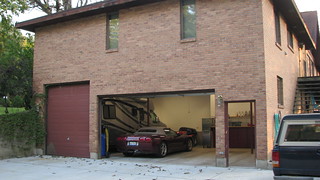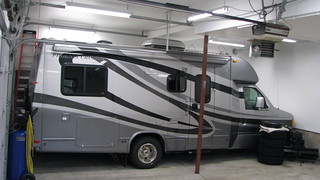- Good Sam Community
- Groups
- Motorhome Group
- Forum
- RV storage
- Subscribe to RSS Feed
- Mark Topic as New
- Mark Topic as Read
- Float this Topic for Current User
- Bookmark
- Subscribe
- Mute
- Printer Friendly Page
RV storage
- Mark as New
- Bookmark
- Subscribe
- Mute
- Subscribe to RSS Feed
- Permalink
- Report Inappropriate Content
Jan-21-2017 11:06 PM
- Labels:
-
Class C
- Mark as New
- Bookmark
- Subscribe
- Mute
- Subscribe to RSS Feed
- Permalink
- Report Inappropriate Content
Jan-24-2017 04:03 AM
I have had no problems with brakes or rotors and have never used an internal heater in storage.
2010 Subaru Impreza Sedan
Camped in 45 states, 7 Provinces and 1 Territory
- Mark as New
- Bookmark
- Subscribe
- Mute
- Subscribe to RSS Feed
- Permalink
- Report Inappropriate Content
Jan-24-2017 02:30 AM
Olddud wrote:
Those carports look nice, especially with sides.
I doubt that they would be allowed in the zoning for much of the Cary area. Perhaps out in a smaller town/location.
bumpy
- Mark as New
- Bookmark
- Subscribe
- Mute
- Subscribe to RSS Feed
- Permalink
- Report Inappropriate Content
Jan-23-2017 03:13 PM
- Mark as New
- Bookmark
- Subscribe
- Mute
- Subscribe to RSS Feed
- Permalink
- Report Inappropriate Content
Jan-23-2017 10:11 AM
We've used one of these inexpensive carports for years to protect our 2002 family sedan. It's exterior is still in pristine condition being protected this easy way. I sunk concrete footings into the ground and bolted the carport's posts to the concrete to keep the carport in place during heavy winds.
- Mark as New
- Bookmark
- Subscribe
- Mute
- Subscribe to RSS Feed
- Permalink
- Report Inappropriate Content
Jan-23-2017 04:46 AM
Gary
- Mark as New
- Bookmark
- Subscribe
- Mute
- Subscribe to RSS Feed
- Permalink
- Report Inappropriate Content
Jan-22-2017 03:14 PM
- Mark as New
- Bookmark
- Subscribe
- Mute
- Subscribe to RSS Feed
- Permalink
- Report Inappropriate Content
Jan-22-2017 09:51 AM
I have never heard of brake pads or rotors dying in a couple years from being stored outside. Brake fluid, being hydrodcopic, should be changed out every few years regardless of storage conditions.
- Mark as New
- Bookmark
- Subscribe
- Mute
- Subscribe to RSS Feed
- Permalink
- Report Inappropriate Content
Jan-22-2017 08:23 AM
It's the sun that's the worst enemy of RV exteriors. It not only fades colors - which can be slowed down with good waxing habits - but most importantly it drys out, hardens, and cracks sealants around all side and roof openings.
Humidity is the worst enemy of RV interiors. If you store it anyway other than inside in a heated room - it's important to keep the inside of the RV ventilated and, if possible, heated somewhat using a small heater set on on a low setting. The small air circulating heaters used in cabin boats when stored moored at a dock are good for this. We keep both rooftop vents open all the way (they have roof covers over them) during the winter rains and a small electric heater turned on during the rainy season. The coach interior should be kept ventilated and warm. We once almost ruined a motorhome by keeping it all closed up and unheated during cold, wet winters - mold formed everywhere inside. That's one thing that really concerns me about those complete canvas covers for RVs. They keep the sun's UV rays from ruining the outside ... but they also prevent interior air circulation and interior heating during moist winters. They trap moisture all over the RV inside and out so mold can form inside and out.
Keeping your rig under a carport, with roof vents open and a small heater inside during the winter is probably the best way to store it other than the very expensive way of inside a heated space. A small heater can be set on a moderater setting and plugged into an inexpensive mechancal timer so that it only comes on nights during cold and wet seasons.
- Mark as New
- Bookmark
- Subscribe
- Mute
- Subscribe to RSS Feed
- Permalink
- Report Inappropriate Content
Jan-22-2017 06:19 AM
I think one of the big differences between a tarp and a cover is that a tarp gets rigid in cold weather. Combine that with wind and it can cause problems. If you can keep the tarp tight over the camper, it might not be as big a potential hazard. Covers I have seen do not get rigid. Good covers are also breathable, so they do not trap moisture.
-Michael
2017 Jayco Jayflight Bungalow 40BHQS Destination Trailer
2009 Jayco Greyhawk 31FS Class C Motorhome (previously owned)
2006 Rockwood Roo 233 Hybrid Travel Trailer (previously owned)
1995 Jayco Eagle 12KB pop-up (previously owned)
- Mark as New
- Bookmark
- Subscribe
- Mute
- Subscribe to RSS Feed
- Permalink
- Report Inappropriate Content
Jan-22-2017 05:13 AM
Just say NO to TARPS!
Years ago, my BIL and I decided we would leave campers outdoors but tarp them.
We each purchased tarps large enough to cover each of our campers.
We took every step we could to secure the tarps.
In the spring I had a few areas where the paint was worn off the camper.
My BIL hd a HOLE worn right through his door. It appeared that a gromett had enough wiggle room that, blowing in the wind, it slowly rubbed right through the door.
TV: 2010 Nissan Titan Pro4X Crew Cab
- Mark as New
- Bookmark
- Subscribe
- Mute
- Subscribe to RSS Feed
- Permalink
- Report Inappropriate Content
Jan-22-2017 04:59 AM
We have indoor heated storage for our rig. It is coming up on it's 10th birthday and it actually still smells new inside. The tires are original (don't crucify me for that please) and I don't plan to change them anytime soon. I think the rig now has near 35,000 miles which is not a lot for it's age which means it sits a lot. If I stored it outside, I'd have to replace brake pads and rotors every-other or third year. But with our rig, I have not even loosened one lug nut yet. The rig stays that well preserved. If I was not a hands-on guy and kept our rig outside, I think we would have spent-to-date approximately $25,000 on outdoor storage, 3 sets of tires, 3 brakes jobs, and all the other stuff that degrades and goes bad needing repair from sitting outside. Sun, rain, snow, sub-zero freezes, tires in puddles, ground moisture, rodents, all combined are brutal on a motor home. Hopefully you'll never have storm or hail damage, vandalism/break-in/theft, or a storage neighbor accidentally damaging your rig.
So do the rough math. $25,000/10 years = $2,500/year in savings by storing our Phoenix Cruiser at home in our garage. So it seems you could break even by paying $2,500 a year for indoor storage for 12 months a year.
Then add in the "reliability factor". We have less trouble than most others. Actually we have never had any trouble with our rig when using it except once needing a new chassis battery.
Then there is the resale value of a perfectly preserved rig. People who don't know us well enough and come by to visit us, they think we just bought it.
Here is our rig at home. The past week here it has been unseasonably warm in January, very damp & humid outside which makes it damp inside the garage. Being that warm outside, I crank up the garage heater to 70 degrees which dries out the room keeping everything inside in good condition. When it gets real cold, I will lower the temp to around 58.


Look around for local commercial buildings in your area offering indoor heated storage. With our new president promising to turn things around, vacant buildings might get scarce (I sure hope so) but for now they are everywhere.....at least they are abundant here in the Chicago n/w suburbs.
- Mark as New
- Bookmark
- Subscribe
- Mute
- Subscribe to RSS Feed
- Permalink
- Report Inappropriate Content
Jan-22-2017 04:48 AM
We have a tarp we put over the top when stored but, are interested in using a purpose made cover.
Gary
- Mark as New
- Bookmark
- Subscribe
- Mute
- Subscribe to RSS Feed
- Permalink
- Report Inappropriate Content
Jan-22-2017 03:52 AM
- Mark as New
- Bookmark
- Subscribe
- Mute
- Subscribe to RSS Feed
- Permalink
- Report Inappropriate Content
Jan-22-2017 03:13 AM
bumpy





